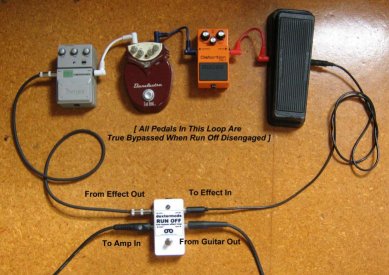1/. What is True Bypass?
The term “True-bypass” refers to a method of wiring a pedal’s stomp switch such that when the pedal is in bypass mode, your clean signal goes in one jack and out the other. The signal does not pass through any active circuitry that can corrupt your original tone. Many pedals employ a signal buffer instead of a true-bypass design, unfortunately if this buffer is poorly designed your pedal will “suck tone” when in bypass mode.
2/. Can all effects pedals be wired as True Bypass.
Yes they can, but it’s sometimes an expensive option requiring the pedal to be rehoused in a larger enclosure. A much simpler and just as effective option is to have a True Bypass switching circuit wired into your signal chain and create a True Bypass loop. This is what the Run Off pedal does.
3/. Why do you call it a Run Off pedal?
All of my own mods have a rural theme in their name. A run off is a place where you send your stock to graze while you clean up your good pasture.
4/. How do I connect the Run Off pedal into my signal chain?
You will need two guitar leads and two patch cables. Plug your guitar lead in to the Run Off ‘Input’ jack, plug your amp lead into the Run Off ‘Output’ jack. Using a patch cable plug your effect pedal input into the Run Off ‘Send’ jack. Use another patch cable plug your effect pedal output into the Run Off ‘Return’ jack. You can add as many pedals as you want into the loop between the Run Off Send and Return jacks. To True Bypass the pedal loop just use the footswitch and all pedals in the loop are true bypassed and your signal chain from guitar to amp is not affected by any of the pedals in the Send Return Loop.
5/. How do I change the Battery?
Unscrew the 4 screws on the back of the pedal to replace the battery. The battery only powers the On/Off Indicator L.E.D light so if you want to run the pedal with out the indicator L.E.D you can do that.
6/. Do all pedals need to be True Bypassed?
No. Some pedals are notorious tone sucking devices, others have very good buffer circuits that do the bypass job very well. You can leave these pedals out of the Run Off Send Return Loop if you want and just plug them into your signal chain where you normally would have them between the guitar and amp.
7/. Sometimes I can hear a slight clicking sound through my amp when I engage the Run Off Pedal?
Welcome to the world of True Bypass. The sound you hear is not electrical, try unscrewing the Run Off backing plate and removing the 9 volt battery, if you could hear the clicking before, it’s still there. This is a mechanical issue with True Bypass and effect loops. The clicking is the sound of the the unbuffered switch connecting. This problem can be addressed effectively when wiring a True Bypass switch into an effect pedal but it is not so simple in an effect bypass box. The solution to removing the faint clicking sound is to wire in a small buffer, which puts us back to where we started.
8/. The finish on my pedal doesn’t look like the finish on my Boss pedal.
The Run Off pedal is handmade and hand painted so do not expect the look of a mass produced pedal when your pedal arrives in the post. The enclosures are made of etched aluminium and primed with PA10. They are then given three sprayed coats of acrylic enamel. The pedal is then hand assembled and may suffer a few knocks and scratches in the process. Once complete and tested the waterslide decals are applied. All in all it takes about 3 days from start to finish from a bare enclosure to get a finished pedal. I am experimenting with a baking solution to provide a more durable finish and will update when I have mastered this.
As an alternative you can order an unfinished pedal with no paint and no decals. These are discounted by $20.00

